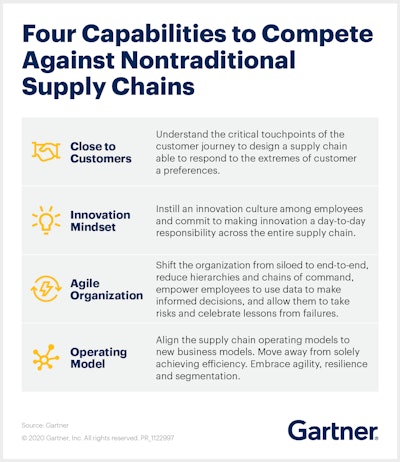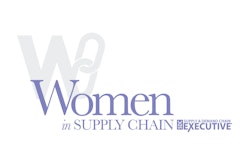
Chief supply chain officers (CSCOs) can adapt capabilities of nontraditional competitors to be better equipped to fit the needs of modern customers and support new business models, according to Gartner, Inc.
“Nontraditional competitors – especially digital giants, such as Amazon and Alibaba, as well as startups – are reshaping industries through disruptive innovation, the ability to uncover and address unknown customer needs and very agile supply chains,” said Pierfranceso Manenti, vice president analyst with the Gartner Supply Chain Practice. “Most CSCOs from large established organizations we interviewed believe that nontraditional competitors are better fit to navigate the disruptions and long-term new realities that the COVID-19 pandemic catalyzed.”
To find opportunity in crisis and compete against their industry’s disruptors, CSCOs must transform their traditional supply chains.
Become Close to Customers
Customer proximity and intimacy – the ability to know which products and services customers really want – is critical for an organization’s success. However, this characteristic is one that many established companies risk losing over time, which opens a window for competitors. As companies are lulled into complacency by long-established strategies in supply chain, sales, marketing and product development gaps arise in product and service offerings. To start getting closer to the customer again, CSCOs must gather voice of the customer (VoC) data and create customer journey maps to discover critical touchpoints.
Instill an Innovation Mindset
Customers want better, cooler and smarter products, and solutions and services with extended capabilities. They also want a continuous flow of innovative products developed and launched without delays.
Survey results show that 44% of respondents are planning to adopt an agile product development methodology to become faster at launching new products. “Established organizations are now planning to operate much like a startup-like when it comes to innovation,” Mr. Manenti added. “To create the necessary innovation culture, CSCOs need to engage their employees with a strong sense of purpose and inspire them with shared beliefs to guide decision making.”
Create an Agile Supply Chain
An agile supply chain organization makes use of self-forming teams and data-driven decision-making to become more responsive. By embracing less hierarchical organizing and leadership models, companies are able to engage more of their talent to develop new ideas across operations, products and customer service.
Align the Operating Model to New Business Models
An advantage that nontraditional competitors frequently have over established companies is that they don’t follow the established supply chain conventions. These new competitors — especially emerging startups — often solely focus on achieving innovation as their business goal, instead of having to achieving the performance metrics that management and markets expect from established companies.
“Many supply chain executives operate separate supply chain segments within their global networks to support emerging new products. Those segments rely on third-party contract manufacturers and use different distribution channels than the traditional supply chain. This combination of conventional and innovative supply chain segments is a recipe for success for traditional organizations,” Mr. Manenti concluded.



![Pros To Know 2026 [color]](https://img.sdcexec.com/mindful/acbm/workspaces/default/uploads/2025/08/prostoknow-2026-color.mduFvhpgMk.png?auto=format%2Ccompress&bg=fff&fill-color=fff&fit=fill&h=100&q=70&w=100)







![Pros To Know 2026 [color]](https://img.sdcexec.com/mindful/acbm/workspaces/default/uploads/2025/08/prostoknow-2026-color.mduFvhpgMk.png?ar=16%3A9&auto=format%2Ccompress&bg=fff&fill-color=fff&fit=fill&h=135&q=70&w=240)





